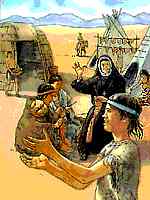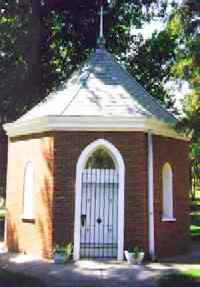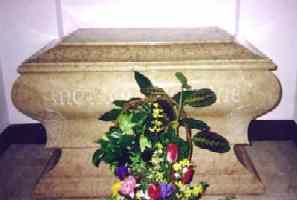Saint Rose Philippine Duchesne, a great pioneer in mission
|
Born in 1769 in Grenoble, in a socially and financially favoured family, little Rose Philippine Duschesne was a school boarder with the Visitation sisters "d'En-Haut". While very young she defied the wishes of her father and remained in the convent as a postulant. She was free to pray. But the French revolution drove the sisters out and took possession of the lovely convent. For Philippine "catacombs" years started. Not only did she practise the forbidden religion, she also visited priests who resisted the government, taught street children and helped needy families.
In 1801, with her own money, she bought her convent and tried to restore contemplative life. Some former Visitation sisters arrived, but obviously, the enterprise was doomed to failure. Philippine did not give up, but contacted the foundress of the young Society of the Sacred Heart and offered to join Madeleine Sophie bringing with her, her companions and the convent itself. In 1804, she became a novice and entered completely in the spirit of the young society. Her greatest difficulty was the removal of her beloved grille, the symbol of the monastic contemplative life-style. In exchange, Madeleine Sophie Barat offered her the "interior spirit". The two friends trained each other in prayer. The following story has been told. Pupils of the boarding-school wondered if Mother Duchesne kept praying on her knees the whole night. To check it, they put on her robe small pieces of paper... which they found the next morning ! One Holy Thursday night in particular is well known, the one Philippine prayed the whole night in adoration.
Her desire for distant missions was great and she often tried to obtain the "yes" for departure from Mother Barat. Meanwhile, she was an excellent general secretary. Finally, in 1818, she got the yes she was longing for. Monsignor Dubourg, bishop of Saint Louis was given on a small team of five sisters who embarked on the Rebecca for Louisiana. After the difficulties of the three-month long journey, came those of settling down in a deserted place, (the realism of the bishop was not in line with his goodness). In addition, there were financial problems, such that the group depended on an unpredictable patron, the children's lack of respect for rules, the delay in sending additional personnel, the lack of spiritual help.
Of course, there are also joys, the hospitality of Ursuline Sisters who welcomed the newcomers, the mail from France, although it took several months to cross the ocean... unless it sank in the river with the boat, the true friendship with Father Louis Barat, who sent help and hymn-books he wrote for the Algonquin Indians, the enthusiasm of American novices...
The work grew and houses multiplied. Time passed, with intense activity in the service of education, with joys and sorrows, among them a two-year silence on the part of her friend Madeleine Sophie Barat. This is still a puzzle : lost or intercepted mail ? Overload of Madeleine Sophie overwhelmed with a crisis that might have ruined the Society ? In that conflict between the Church in Rome and the gallican Church, where to position oneself ? Being so far away made it very difficult to have correct information.
 Philippine, who
had gone to the missions to announce Jesus Christ to the Indians, for a long
time didn't see her desire fulfilled. It was on the insistence of Father
Desmet, a well-known black-robed apostle, that she finally got permission to
leave for Sugar Creek, amongst the Indians. For him, the character of that
woman completely vowed to God and others outweighed the decline in her health. Among
the Potowatomi tribe, she became Quah-hak-ka-num-ad,
the woman who always prayed. Present in Rome in 1988, for the celebration of her
canonisation, a Potowatomi chief spoke of the oral tradition of his tribe who
cannot forget the one who taught the women and girls to pray. This teaching,
which put down so deep roots, lasted only about one year... Which guru of today
could expect such a success ?
Philippine, who
had gone to the missions to announce Jesus Christ to the Indians, for a long
time didn't see her desire fulfilled. It was on the insistence of Father
Desmet, a well-known black-robed apostle, that she finally got permission to
leave for Sugar Creek, amongst the Indians. For him, the character of that
woman completely vowed to God and others outweighed the decline in her health. Among
the Potowatomi tribe, she became Quah-hak-ka-num-ad,
the woman who always prayed. Present in Rome in 1988, for the celebration of her
canonisation, a Potowatomi chief spoke of the oral tradition of his tribe who
cannot forget the one who taught the women and girls to pray. This teaching,
which put down so deep roots, lasted only about one year... Which guru of today
could expect such a success ?
When the mission was accomplished, Philippine entered into a silence full of His Presence. She continued to be generous in everything, living under a staircase, happy with very little. Finally, she was freed from the responsibilities of which she had always considered herself unworthy.
On November 18, 1852, she returned to God at Saint Charles, Missouri. There, people come to pray to her and to give praise to God for Philippine who loved so much at such cost of herself.
|
|
|
|
Funeral chapel |
Tomb at Saint Charles |
She was beatified in May 1940 and canonised in July 1988.
More information on Saint Rose-Philippine Duchesne is available at the following website :
http://www.catholiclinks.org/santossaintrosephilippineduchesne.htm
In addition, the following books are recommended :
|
Sainte Philippine Duchesne, (1769-1852) une Française pionnière au Missouri, by Raymond Peyret Editions Peuple Libre, Desclée de Brouwer |
|
Philippine Duchesne, Frontier Missionary of the Sacred Heart by Louise Callan, rscj Newman Press 1957 |
Last update: 2006-10-31


